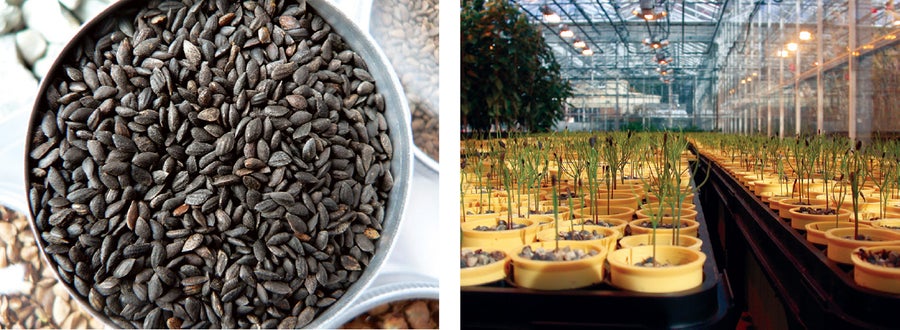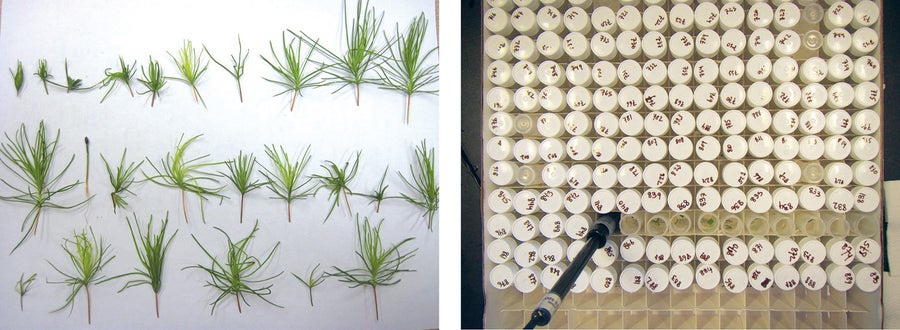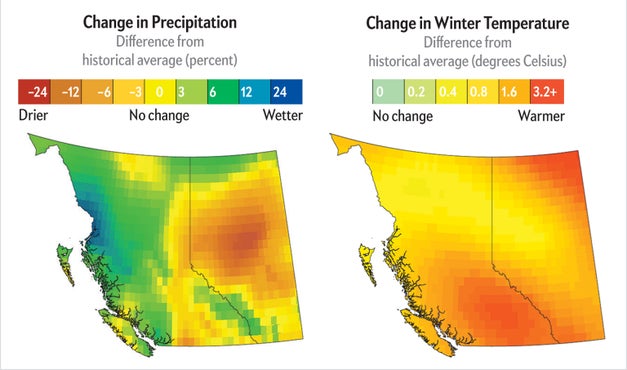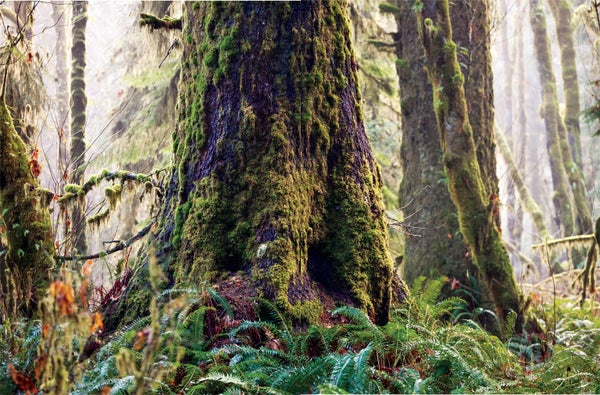In a field in Vancouver, across the road from a row of tidy white townhomes, roughly 500 bushy Sitka spruce trees climbed toward the sun. On a spring day in 2013 the trees, triangle-shaped with tightly packed, deep-green needles, were crammed shoulder to shoulder—or, in some cases, shoulder to waist. Although the spruces were all planted at the same time, seven years earlier, their height varied like primary schoolchildren assembled for a group photograph.
The smallest trees, around two feet tall, hailed from Kodiak Island, Alaska; the tallest, at nearly seven feet, originated in Oregon. Height was not the only visible difference. The spruces from Alaska produced buds a full three months earlier—an entire season—than those from Oregon. The Alaska trees also stayed green and healthy no matter how low the temperature dropped.
The spruces had been rooted in this field, at one end of the University of British Columbia’s rambling campus, as an experiment to highlight how trees adapt to local environments. That trees match their habitats may sound obvious. But the details are important because of a looming threat: those habitats are changing as the planet warms—and trees can’t exactly get up and walk to a new home. If a species cannot keep pace with a changing climate, it is doomed.
On supporting science journalism
If you're enjoying this article, consider supporting our award-winning journalism by subscribing. By purchasing a subscription you are helping to ensure the future of impactful stories about the discoveries and ideas shaping our world today.
Because the trees themselves cannot relocate, scientists are exploring a novel solution: relocating the plants’ DNA. That is why Sally N. Aitken planted the spruce garden. Aitken, director of the university’s Center for Forest Conservation Genetics, believes saving the forests of British Columbia—and others around the world—may hinge on a practice called assisted gene flow. It could help species adapt to future conditions by moving organisms with particular traits from one part of their natural range to another. The tree from Oregon and the tree from Alaska just might have some genes that could help each other out. But without intervention, they would never meet.
Like an arboreal matchmaker, a forester could take seeds from spruces or lodgepole pines at a low elevation, say, and plant them farther upslope. As temperatures on the higher slopes warmed, the relocated trees would grow up and breed with their local counterparts, spreading their warm-adapted genes throughout the area and thus helping the forest adjust. Assisted gene flow could give species an evolutionary hand.
But you can’t simply take a tree from Oregon, plant it 1,000 miles away in northern British Columbia and wait for the mercury to rise. The reasons that you can’t come from the same local genetic adaptations that make the gene-flow idea attractive. Lodgepole pines, for instance, grow in different regions throughout much of the Canadian province. Their genes help some trees better tolerate heat or cold or drought or fend off local diseases or pests. If an Arctic cold front moves through Vancouver, hitting transplants from warmer regions, they will suffer. “We need to shift these things starting with baby steps,” Aitken says. “The changes projected over the next few decades are really big, but we still have a lot of year-to-year and week-to-week and month-to-month variation that those trees have to survive.”
Figuring out how to match today’s seeds with tomorrow’s climates is no easy task. But in British Columbia, where forestry accounts for a third of all exports and commercial forests make up nearly half of the total forest cover, it is vital. Provincial law requires that forests be replanted after logging, to bolster future timber supplies and healthy ecosystems. Roughly 250 million seedlings are planted annually. Just where those seeds should come from and how far they can or should be moved is a complicated—and pressing—question. Do it wrong, and you could be dooming the forests for decades to come.
The Sitka spruce experiment, which involved trees from 14 different locations ranging from central California up to Alaska, was Aitken’s small proof of concept for a larger effort to avoid this type of fatal misstep. The research yielded 35 segments of DNA associated with cold tolerance and bud timing. Next Aitken and her team sifted through more tree genomes to find genes responsible for proteins that are linked to other environmental traits. By examining these genes and comparing them among species (lodgepole pine and two varieties of spruce), they were able to show that closely related species adapted in similar ways using the same genes. Their hope is that beneficial versions of these genes—called alleles—would spread through populations that need the traits, in rough synchrony with the climate changes that make those genes useful.
The project, called AdapTree, as well as a more recent effort, CoAdapTree—which looks at three more species of conifer—could help pave the way for future assisted gene-flow projects around the world, work that could in turn help other species that are key ecosystem architects. Started in the fall of 2016, the project looks not just at climate adaptation but also at two tree diseases. “Insects and diseases are increasing their impact as the climate warms,” Aitken says. The effort is co-led by a forest pathologist, Richard Hamelin, and is examining both tree responses to the diseases and the ways that the pathogens themselves vary genetically.
Aitken and Michael C. Whitlock, a population geneticist in the university’s zoology department, coined the phrase “assisted gene flow” in a 2013 paper. Over the past decade scientists and conservationists have been arguing over a more grandiose idea, “assisted migration,” which generally refers to moving species greater distances, outside their natural ranges. But assisted gene flow within a species’ range is a more measured approach with genetic rigor at its heart. By the time AdapTree wrapped up, scientists had assembled DNA-sequence information for 12,000 lodgepole pine and spruce trees from more than 250 populations across British Columbia and Alberta.
Climate Zones
Those trees are already feeling the effects of a changing climate. Back in the 1970s, British Columbia’s government produced a climatic map of the province, organizing it into a series of biogeoclimate zones. That map has underpinned forest planning in western Canada for four decades, helping to govern which seeds can be planted where. Today, though, thanks to climate change, nearly a quarter of the map is obsolete. Some zones have moved, and others have dwindled dramatically. High-elevation zones and some interior plateaus have already lost around half their habitat—and could shrink by more than 80 percent by 2100. Seeds of trees that once would have thrived in a particular area might today be unable to even grow there. Zones may morph into ecosystems that are fundamentally different from what existed before, although exactly how much change is required before an ecosystem is “fundamentally different” is unclear and controversial.
Whether a particular population can adapt to change depends in part on how quickly the organism reproduces. Each new generation represents a chance to acquire useful traits. So a pine beetle, which reproduces quickly, has a much better chance of adapting than a tree, which is long-lived and slow to reproduce. A single bug may witness no change at all during its life span. A tree, though, has a front-row seat to global warming.
A stand of forest is most at risk during its first 20 years of life. Once the trees are established, they become far more resilient, “able to stick around for a while,” says Brad St. Clair, a research geneticist at the U.S. Forest Service in Corvallis, Ore. But in the era of global warming, local conditions can change considerably over those two crucial decades.
“If you’re going to move things to higher elevations so they’d be adapted to future climates,” St. Clair says, “then they have to be adapted to cold-hardiness now.” In other words, if you move warm-adapted trees now into a zone that is projected to warm in the future, those trees could be in short-term trouble because the zone is still cold today.
“We’ve got a moving target,” Aitken admits. “Do we want to best match trees with climate when they’re seedlings? Or 10 years old? Or 30 years old?” One way to manage risk is to increase diversity—which might mean mixing local and nonlocal seeds. “You don’t want to do the same thing on every hectare of ground. You can’t plan around a single climate change scenario.”
Assisted gene flow may be a good way to bulk up a forest’s genetic diversity, sprinkling its gene pool with the ingredients that give trees a boost. As the environment shifts, some trees may suffer in the short term, but other trees will have genetic material that could help the forest weather tough times. “As those individuals that are more fit reproduce more,” Aitken says, “we expect populations to start expanding again.” The critical element, she says, is maintaining enough healthy trees to mate and survive while the process of adaptation unfolds.

Seeds of change: The AdapTree experiment gathers seeds from different habitats (left). Pine seedlings grown in the project's greenhouse (right). Credit: Jack Woods AdapTree project, University of British Columbia (left); Connor Fitzpatrick AdapTree project, University of British Columbia (right)
Aitken, an avid backpacker and backcountry skier who owns a cabin in the woods of central British Columbia, hopes her work will help set new, smarter forest policy. She believes that if we do not begin practicing assisted gene flow, tree populations may begin to fail at the far northern or southern edges of species’ ranges. “Trees might persist a long time, but they might stop reproducing,” she says. “They’d be evolutionarily toast.” They would become, she adds, a “land of the living dead.” What’s worse, they would hog space and sunlight that seedlings desperately need. Closer to the middle of a range, things would be a bit less dramatic. But trees might still grow more slowly or have trouble surviving. “Does that mean the populations there are just going to die?” Aitken asks. “Probably not. There’s a lot of variation within populations. The species aren’t going to go extinct, but I imagine you’d have pretty unhealthy-looking forests in the meantime.” The poor health would harm other plants and animals because trees anchor entire ecosystems, providing food and shelter, regulating water flow and preventing soil erosion.
Around the world, Aitken says, “there has been very little attention paid to the movement of individuals within existing species ranges.” The ecological risks are lower than transplanting truly foreign trees because such foreigners are not already part of the ecosystem, even though they may possess some desirable traits.

Pine seedlings show variation in shape (left). Some needles are tested with a probe (black rod) to see whether they can resist freezing temperatures (right). Credit: Jack Woods AdapTree project, University of British Columbia (left); Pia Smets AdapTree project, University of British Columbia (right)
There are still risks to a gene-flow approach. It could, for instance, add local gene variants that would actually harm a larger population’s chance for survival. “There is a risk that you could be introducing unwanted alleles,” says Andrew Weeks, a geneticist at the University of Melbourne. But the problem would likely correct itself, he adds. “That’s the beauty of natural selection, which will weed out these variants. By increasing the gene pool, you are giving the population the best chance for the future.”
With British Columbia’s forests worth $10 billion a year—as well as providing vital services such as preventing floods and soil erosion—doing nothing may pose an even greater risk. British Columbia has already seen what global warming can do to forests. Since the mid-1990s beetle invasions and wildfires, both linked to warming temperatures, have destroyed millions of acres of forest and consumed hundreds of homes. “We’ve had lots of wake-up calls here in terms of climate change,” says Gregory O’Neill, a research scientist at British Columbia’s Ministry of Forests and Range. The insects and fires, O’Neill says, left people in the province “quite cognizant of climate change—and not that it’s some abstract thing in the future, but it’s already happening.”
The losses jolted the provincial government into action. In 2009 British Columbia began revising its rules on moving seed. That same year O’Neill began an assisted migration trial for the province’s forests, hoping to determine whether, where and how foresters might plant completely different species after harvesting. At 48 sites throughout Canada and the western U.S.—from Whitehorse to Sacramento—researchers planted 15 species of commercially important trees, moving them from their home range and, in some cases, relocating them thousands of miles away.
The extreme migration, O’Neill says, is merely a research tool, a way to provide a better overall picture of how the trees will fare. It is not intended as a guide for long-distance moves. Any actual changes in planting patterns will be incremental. “Something like ‘Do not move your trees downhill’ or ‘Do not move your trees south,’ ” he says. There is a weather station at each site, and the study will show how the growth and survival of the seedlings relate to the local conditions. Then, O’Neill says, scientists will be able to predict how the trees will respond to climate change.
The genetic analysis of AdapTree offers a complementary way to predict how the trees will fare. Researchers on the sprawling project pored over DNA sequences from millions of locations in the genomes of interior spruce and lodgepole pine trees. They developed a quick screening method—similar to that used by the human genome screening business 23 And Me—that looks at roughly 50,000 short strings of genetic code, known as single nucleotide polymorphisms, or SNPs. With that done, they dug in, as Aitken put it, trying to zero in on the specific polymorphisms that match a tree to its home base.
The raw genetic data from AdapTree are dizzying. Printed on both sides of sheets of 8½ by 11 paper, Aitken notes, the stack would rise at least 90 miles. And that is only part of the information. Researchers are now looking at how the genes actually function—how their instructions are carried out—when the trees encounter stresses such as drought or high temperatures.
Forests of the Future
A few degrees of latitude south, specialists in the U.S. Forest Service are beginning to weigh the pros and cons of assisted gene flow. “Where we’re at is a lot of talk and discussion,” St. Clair says. In the U.S., foresters historically did not focus on specific climate variations within zones where they collected and planted seeds. Moving seeds in a zone did not appear to involve enough temperature change to affect plant health.
Now foresters generally agree they need to get much better at moving seed. For as long as people have been planting trees, we have been relocating seed across rivers, villages, continents or oceans. “If you go back far enough, people used to move seed around all the time, and you’d often end up with failed plantations because people had no idea what they were doing,” says Glenn Howe, a forest geneticist at Oregon State University. Partly as a result of those failures, over time the forestry community developed an aversion to risk. In the western U.S., seed zones, which guide how far seeds can be moved for planting, are narrow and conservative. “That’s probably appropriate in a static climate,” Howe says. “But with climate change, a very conservative approach could be a problem.”
British Columbia is forging ahead. The province recently released new guidelines for reforestation, based in part on AdapTree’s findings. Roughly 300 million seedlings were to be planted to regrow commercial forests in B.C. last year. As of April 2018, the guidelines were voluntary, to give companies time to shift their seed inventory, but within a couple of years they will be the rule.
Of course, broader challenges to assisted gene flow remain. For the moment, researchers will need to convince resource managers to trust in genomic data, something they cannot see for themselves in the field. Aitken says viewpoints are definitely shifting, particularly surrounding the idea of moving things around within a species’ range. “I won’t say there’s no resistance, but there’s not a lot of resistance,” she says. Still, it is crucial that all those nucleotide polymorphisms and sequence data “translate into a forester’s lexicon,” Aitken says.
Because ultimately all those strands of DNA make up living, breathing trees—the ones we depend on to construct our built environments as well as our natural ones. To thrive in a changing world, some of those trees may need to branch out into new territory. And to do that, they are going to need our help.

Weather Trends for Trees
Scientists compared the past with the present to figure out recent climate trends in British Columbia and Alberta and whether they depart from what trees experienced during the latter half of the 20th century. Researchers gathered direct observations from weather stations throughout the provinces between 1961 and 1990. The scientists compared this baseline with averages from a more recent period, 1997 through 2006. For the recent period, they noted whether the averages were wetter, drier or warmer or did not change from the earlier averages. They learned that the climate has become much wetter along the Pacific coast, which the researchers link to outbreaks of previously rare pine needle blight. At the same time, it has become drier in the interior, which may account for spruce and aspen deaths there. Winters have been warmer all over the provinces, allowing the tree-killing mountain pine beetle to spread to more forests. (Methods for this analysis were published in 2009 in Agricultural and Forest Meteorology.)
Credit: Andreas Hamann

